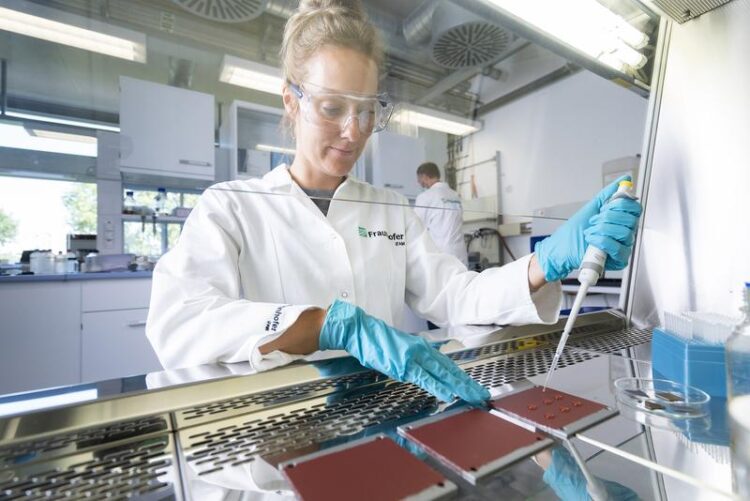Investigation of antiviral surfaces for material developers

Sample preparation for the evaluation of antiviral surfaces.
© Fraunhofer IFAM
The need for everyday objects with antiviral surfaces is high due to the COVID 19 pandemic. It is known that the material composition of an object has an influence on the viability of viruses on surfaces. This is where the work of the Fraunhofer IFAM comes in: In cross-disciplinary research projects between material science and biology, the effect of functionalized surfaces and treatment processes on the survival time of viruses is evaluated for various materials using real-time PCR tests. The detection system is also of interest to material developers from industry who want to optimize their products with regard to antiviral effectiveness.
The time viruses can survive without their host cells depends on many factors. The ambient temperature, air humidity, UV radiation as well as the material composition and properties of a surface have a significant influence. For example, although the amount of detectable viruses decreases under all experimental conditions, investigations also show that the materials remain infectious for very different lengths of time.
While the viruses survived up to 72 hours on plastic and up to 48 hours on stainless steel, no viruses could be detected on copper after four hours and on cardboard after 24 hours [1]. The aim of the research projects at Fraunhofer IFAM is to reduce the risk of contagion through contact infections of everyday materials. Antiviral coatings, treatment methods or surface modifications are used for prevention. Interested companies can accompany the development work or have their own material developments tested.
Use of real-time polymerase chain reaction (qPCR) to test antiviral effectiveness
New solutions require a reliable method for testing their effectiveness. Reliable, fast and precise test procedures are therefore essential for the development of antimicrobial surfaces. Fraunhofer IFAM uses therefore quantitative real-time PCR (qPCR). qPCR is a method for the amplification of nucleic acids based on the principle of the conventional polymerase chain reaction (PCR).
In addition, it allows for a quantification of the obtained nucleic acids. The quantification of the samples under investigation is performed by means of fluorescence measurements, which are recorded in real time during a PCR cycle. The fluorescence increases proportionally with the amount of PCR products. This allows comparing the efficiency of the tested surfaces in absolute and relative terms.
[1] Van Doremalen N, Bushmaker T, Morris DH, Holbrook MG, Gamble A, Williamson BN, et al. Aerosol and surface stability of SARS-CoV-2 as compared with SARS-CoV-1. The New England Journal of Medicine 382;16 (2020).
Wissenschaftliche Ansprechpartner:
Tim Heusinger von Waldegge
Fraunhofer Institute for Manufacturing Technology and Advanced Materials IFAM
Wiener Straße 12 | 28359 Bremen, Germany | www.ifam.fraunhofer.de
Phone +49 421 2246-7377
tim.heusinger@ifam.fraunhofer.de
Media Contact
All latest news from the category: Materials Sciences
Materials management deals with the research, development, manufacturing and processing of raw and industrial materials. Key aspects here are biological and medical issues, which play an increasingly important role in this field.
innovations-report offers in-depth articles related to the development and application of materials and the structure and properties of new materials.
Newest articles

Properties of new materials for microchips
… can now be measured well. Reseachers of Delft University of Technology demonstrated measuring performance properties of ultrathin silicon membranes. Making ever smaller and more powerful chips requires new ultrathin…

Floating solar’s potential
… to support sustainable development by addressing climate, water, and energy goals holistically. A new study published this week in Nature Energy raises the potential for floating solar photovoltaics (FPV)…

Skyrmions move at record speeds
… a step towards the computing of the future. An international research team led by scientists from the CNRS1 has discovered that the magnetic nanobubbles2 known as skyrmions can be…





















